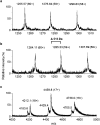The carbon chain-selective adenylation enzyme TamA: the missing link between fatty acid and pyrrole natural product biosynthesis
- PMID: 29594310
- PMCID: PMC5939613
- DOI: 10.1039/c8ob00441b
The carbon chain-selective adenylation enzyme TamA: the missing link between fatty acid and pyrrole natural product biosynthesis
Abstract
The marine bacterium Pseudoalteromonas tunicata produces the bipyrrole antibiotic tambjamine YP1. This natural product is built from common amino acid and fatty acid building blocks in a biosynthetic pathway that is encoded in the tam operon which contains 19 genes. The exact role that each of these Tam proteins plays in tambjamine biosynthesis is not known. Here, we provide evidence that TamA initiates the synthesis and controls the chain length of the essential tambjamine fatty amine tail. Sequence analysis suggests the unusual TamA is comprised of an N-terminal adenylation (ANL) domain fused to a C-terminal acyl carrier protein (ACP). Mass spectrometry analysis of recombinant TamA revealed the surprising presence of bound C11 and C12 acyl-adenylate intermediates. Acylation of the ACP domain was observed upon attachment of the phosphopantetheine (4'-PP) arm to the ACP. We also show that TamA can transfer fatty acids ranging in chain length from C6-C13 to an isolated ACP domain. Thus TamA bridges the gap between primary and secondary metabolism by linking fatty acid and pyrrole biosynthetic pathways.
Figures





Similar articles
-
Coupled Natural Fusion Enzymes in a Novel Biocatalytic Cascade Convert Fatty Acids to Amines.ACS Catal. 2022 Oct 21;12(20):12701-12710. doi: 10.1021/acscatal.2c02954. Epub 2022 Oct 5. ACS Catal. 2022. PMID: 36313522 Free PMC article.
-
Synthesis of N-acyl amide natural products using a versatile adenylating biocatalyst.Medchemcomm. 2019 May 31;10(7):1192-1196. doi: 10.1039/c9md00063a. eCollection 2019 Jul 1. Medchemcomm. 2019. PMID: 31741729 Free PMC article.
-
Purification and Kinetic Characterization of the Essential Condensation Enzymes Involved in Prodiginine and Tambjamine Biosynthesis.Chembiochem. 2020 Apr 1;21(7):1036-1042. doi: 10.1002/cbic.201900503. Epub 2019 Dec 3. Chembiochem. 2020. PMID: 31614061
-
Acyl carrier protein: structure-function relationships in a conserved multifunctional protein family.Biochem Cell Biol. 2007 Dec;85(6):649-62. doi: 10.1139/o07-109. Biochem Cell Biol. 2007. PMID: 18059524 Review.
-
Structural basis of the nonribosomal codes for nonproteinogenic amino acid selective adenylation enzymes in the biosynthesis of natural products.J Ind Microbiol Biotechnol. 2019 Mar;46(3-4):515-536. doi: 10.1007/s10295-018-2084-7. Epub 2018 Oct 5. J Ind Microbiol Biotechnol. 2019. PMID: 30291534 Review.
Cited by
-
A universal pocket in fatty acyl-AMP ligases ensures redirection of fatty acid pool away from coenzyme A-based activation.Elife. 2021 Sep 7;10:e70067. doi: 10.7554/eLife.70067. Elife. 2021. PMID: 34490847 Free PMC article.
-
Transcription Factor-Based Biosensor for Dynamic Control in Yeast for Natural Product Synthesis.Front Bioeng Biotechnol. 2021 Feb 5;9:635265. doi: 10.3389/fbioe.2021.635265. eCollection 2021. Front Bioeng Biotechnol. 2021. PMID: 33614618 Free PMC article. Review.
-
Therapeutic Potential of Marine Probiotics: A Survey on the Anticancer and Antibacterial Effects of Pseudoalteromonas spp.Pharmaceuticals (Basel). 2023 Aug 1;16(8):1091. doi: 10.3390/ph16081091. Pharmaceuticals (Basel). 2023. PMID: 37631006 Free PMC article. Review.
-
Coupled Natural Fusion Enzymes in a Novel Biocatalytic Cascade Convert Fatty Acids to Amines.ACS Catal. 2022 Oct 21;12(20):12701-12710. doi: 10.1021/acscatal.2c02954. Epub 2022 Oct 5. ACS Catal. 2022. PMID: 36313522 Free PMC article.
-
An Overview on Industrial and Medical Applications of Bio-Pigments Synthesized by Marine Bacteria.Microorganisms. 2020 Dec 22;9(1):11. doi: 10.3390/microorganisms9010011. Microorganisms. 2020. PMID: 33375136 Free PMC article. Review.
References
-
- Newman D. J., Cragg G. M. J. Nat. Prod. 2016;79:629–661. - PubMed
-
- Carte B., Faulkner D. J. J. Chem. Ecol. 1986;12:795–804. - PubMed
-
- Paul V. J., Lindquist N., Fenical W. Mar. Ecol.: Prog. Ser. 1990;59:109–118.
-
- Pinkerton D. M., Banwell M. G., Garson M. J., Kumar N., Odorico de Moraes M., Cavalcanti B. C., Barros F. W. A., Pessoa C. Chem. Biodiversity. 2010;7:1311–1324. - PubMed
MeSH terms
Substances
LinkOut - more resources
Full Text Sources
Other Literature Sources
Medical
Miscellaneous

